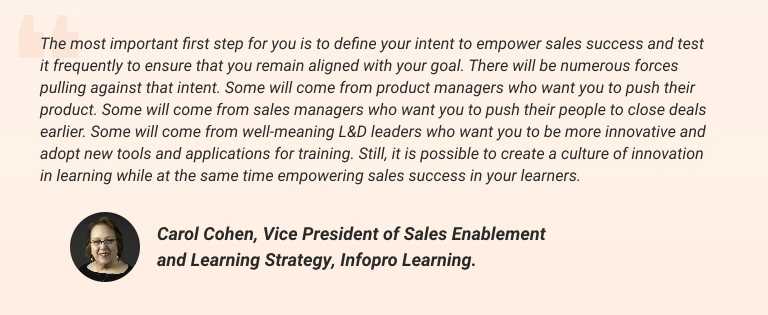Embracing the concept of sales and fostering a genuine appreciation for salespeople is key to empowering sales success. The challenges they face are significant, and providing support is essential for their triumph. This sets sales training projects apart from other programs in Learning & Development (L&D).
The constantly changing and competitive landscape of sales demands that salespeople continuously learn and adapt to stay ahead. An effective sales training program is not just a checkbox in the L&D leaders manual; it is the lifeblood that nurtures a high-performing sales team. But what truly constitutes an outstanding sales training program that stands out in today’s competitive market?
Sales training programs have a crucial function in refining the expertise and know-how of sales professionals, preparing them to excel in the constantly changing business environment. According to Salesforce, 80% of high-performing sales teams rate their training as “very good” or “outstanding.” This statistic underscores the undeniable significance of a strong sales training program. It’s not merely an option; it’s necessary for any organization aiming to outperform the competition and stay ahead in the race.
In this blog, we will dissect the core elements that compose an effective sales training program. From customized curriculum design to the incorporation of cutting-edge technology, we’ll explore how these components contribute to the overall success of sales training, empowering the sales force to close more deals with less effort
Understanding the Landscape: Adapting to the Digital Age
Today, with all the digital technology, the best ways to sell things are always changing. The traditional more transactional sales methods from the past are adapting to accommodate the needs of a tech-savvy and well-informed customer base who requires a consultative partner. Sales professionals must proactively learn about the latest sales trends and developments to maintain a competitive edge.
That’s where an effective sales training program becomes indispensable. It plays a pivotal role by providing sales teams with the knowledge and skills to navigate this new terrain.

Identifying the Core Components of an Effective Sales Training Program
A. Needs Analysis: Understanding Your Unique Sales Needs
Sales training is not one-size-fits-all. Starting with a learning strategy is a crucial and deliberate step in establishing an effective sales training and enablement approach. This strategy should align the business goals of the organization with the behavioral requirements of the sellers.
Sales training programs have a crucial function in refining the expertise of sales professionals, preparing them to excel in the constantly changing business environment. Recognizing your organization’s distinct sales requirements is the initial step toward success. A thorough needs analysis is crucial, enabling you to identify the specific areas where your salesforce needs improvement.
Moreover, success-driven decision-making should drive and inform the customization of your sales training programs. Determining the business and behavioral metrics will ensure the effectiveness of your sales training. Taking a learner-centric approach empowers you to create tailored training that addresses your organization’s unique challenges.
B. Curriculum Development: Crafting Comprehensive Training
An effectively structured curriculum serves as the foundation of any successful training program. It should encompass every facet of sales, ranging from a deep understanding of the products to honing negotiation abilities. Before developing learning objectives and content, examine the learner personas within your target audience. Acknowledging that different sales roles may require tailored or varied training content is essential. For instance, the training needs of inside sales reps and field sales representatives can significantly differ. Therefore, a versatile curriculum should be designed to accommodate these distinct requirements.
Furthermore, the concept of the content lifecycle is vital. It lets you focus on what content needs regular updates to keep your training program current and relevant. This forward-thinking approach future-proofs your sales training programs.
C. Interactive Learning Methods: Activities and Interactions
In an era where passive training methods are a thing of the past, modern sales professionals crave engaging and interactive learning experiences. These techniques infuse vitality into training sessions, guaranteeing that learners recognize the application of learning concepts in their day-to-day selling and can incorporate what they learn into their personal and professional growth journey.
Here’s how you can achieve this:
- Video-based Learning: Video is a versatile tool catering to various learning preferences, offering a platform for role-playing, live lectures, and narrated slideshows to keep sales representatives thoroughly engaged.
- Audio Recordings: Regularly recording calls and sharing them with the sales team keeps everyone updated on evolving strategies, market trends, and successful sales approaches. Audio recordings provide an option for on-the-go training. Whether your sales team is commuting, performing job duties, or multitasking, audio recordings enable them to absorb valuable knowledge seamlessly.
- Microlearning: This highly effective corporate learning approach simplifies complex concepts into short, digestible modules, ensuring learners can access training conveniently. Device-independent microlearning training solutions seamlessly fit into even the busiest schedules.
- Written Content: For those who prefer reading and reviewing, written materials in PDF format are readily available for downloading and printing. This caters to various learning styles and ensures comprehensive understanding. These resources offer a structured and accessible way to convey essential knowledge and strategies to sales teams. From sales playbooks that outline best practices to in-depth guides on objection handling, the written format ensures consistency and clarity. PDFs facilitate easy distribution, review, and reference, making them invaluable tools for trainers and sales professionals.
- Gamification: Learning through games can be both enjoyable and highly effective. Gamification transforms mundane training programs into competitive and engaging learning experiences. Quizzes, video games, leaderboards, social networking, and other interactive activities keep learners interested and motivated to continue their training journey.
- Role Plays: Role plays are a practical and invaluable way for learners to immerse themselves in real-life sales scenarios. These exercises allow sales representatives to practice handling diverse situations, improving their ability to navigate and excel in sales conversations. Through role plays, learners can enhance their communication skills, objection-handling techniques, and confidence. This practical experience bridges the gap between theory and application, making learning more impactful and relevant to their day-to-day responsibilities.
D. Assessment and Feedback: The Path to Continuous Improvement
When you embark on your sales training program development journey, begin with Levels 3 and 4 of the Kirkpatrick model. Here, the primary focus is on business results (Level 4) and behavioral change (Level 3). This shift in focus ensures that your training is directly aligned with achieving real-world outcomes.
Regular assessments in addition to self-assessments are essential for tracking the progress of your sales team. These assessments help you understand each team member’s strengths and weaknesses so you can find areas where they can improve and give them the training they need. Self-assessments enable learners to identify their gaps and then take responsibility for their growth.
Feedback is equally crucial, as it provides a means for continuous improvement, encouraging individuals to strive for excellence and reach their full potential. Sales training should be a dynamic process that can respond to the evolving needs of your sales force.
Technology and Tools: Enhancing Sales Team’s Training Efficiency
- Learning Management Systems (LMS): Implementing a Learning Management System can streamline the training process, making it more efficient and user-friendly. An LMS centralizes training materials, tracks progress, and offers a platform for interactive learning.
- Analytics and Data-driven Insights: The role of data in sales in any training program is an important factor in maintaining effectiveness. Analytics provide insights into learner progress and enable data-driven decisions. This data-driven approach ensures the training program is constantly refined for optimal learning results.
- AI and ChatGPT: Consider leveraging AI tools like ChatGPT to enhance your sales training program. Establishing and accessing a private content library using AI supports your ability to maintain up-to-date product and solution information within your training assets. ChatGPT can help generate scenario-based assessment questions for you to easily refine for your audience, making the question development process more efficient and effective.
Customization for Different Audiences
- New Sales Reps: Tailored onboarding sales training is crucial for newcomers to your organization. It helps them integrate into your company culture, understand your products or services, and quickly become effective sales reps.
- Seasoned Sales Professionals: Seasoned sales professionals also require continuous training to stay updated on industry norms. Advanced training options, including specialized courses or workshops, are essential to keep experienced sales professionals engaged and continuously improving.
Conclusion: The Three Pillars of Sales Training
Remember the three pillars of sales training – delivering value, being responsive to changes, providing support materials for training managers, and easy accessibility to a library of resources. These pillars underpin a successful sales training program that adapts to the dynamic sales landscape.
An effective sales training program is a carefully crafted recipe for success in the ever-evolving sales landscape. By understanding the evolving nature of sales in the digital age and incorporating the core components discussed in this blog, organizations can equip their sales teams to thrive and outperform the competition.
To explore the vital components of an effective sales training program, we invite you to take the next step towards empowering your sales success. Watch the webinar replay, Empower Sales Success: Practical Strategies for Effective Sales Training, led by Carol Cohen, and gain invaluable insights, practical strategies, and a deeper understanding to elevating your sales training initiatives.





